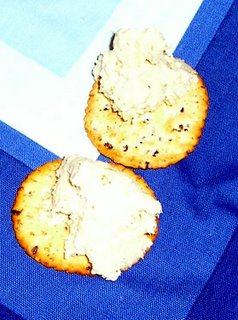Which Came First Salad

I considered calling this creationist salad, but I didn't want anyone to think that I was turning proponents of intelligent design into a lunch product. Especially since V. recently ordered the DVD of the original production of Sweeney Todd, and we watched it last week. Someone might think that I'd gotten ideas. Cannibalism is, of course, a natural subject for musical comedy, but I do not approve of it. Just in case you were wondering.
Anyway. Those of us who believe in natural selection and evolution will tell you that the egg preceded the chicken. Yes, something laid the egg, but it was not a chicken, though one supposes that it must have been very much like a chicken: perhaps it had lips. There was a fortunate mutation, and the egg opened up and out came a chicken.
Creationists, on the other hand, will tell you that the creator made the chicken, which then proceeded to lay eggs. I am not really after a scientific or religious debate here. The chicken comes first in this recipe because it chops very cleanly in the food processor. The eggs should really be chopped last (after the chicken, the cornichons, and the bacon that I did not use but should have used) because they're the hardest to scrape out of the bowl. You might not have to use your spatula until the very end if you process the eggs last. I wrote this recipe the way I actually made it, and that's why the eggs are in the middle. So far as I know, there is relatively little scientific or religious controversy over the origin of cornichons, but I didn't look very hard. It is entirely possible that cornichons had their own patron saint until the end of the nineteenth century when dark forces within the Church had St. Verjus uncanonized (or whatever they do to saints who are no more), but that a small band of true adherents still meets in secret and holds communion ceremonies involving country pate and really good mustard, but I'm probably better off not knowing.
There is no effort at all involved in this recipe if you already have cold chicken and hard boiled eggs in the refrigerator (and you have a food processor). You don't want to throw chicken that's just been cooked and is still warm or hot in the food processor, or you might get a mess, and you will separate the chicken from its moisture, which would be impolite. I did boil eggs just for this salad. I put them in a saucepan of cold water, put them over a medium flame, brought the water to a boil, turned the heat off, put a lid on the pan, let them sit in the very hot water for fifteen minutes, drained the hot water, filled the pan with cold water, and let them sit until they were completely cool, while L. and I watched a movie. Then I dried them off and removed the shell, which came away easily.
I designed this recipe specificially for sandwiches, so I wanted a spread. As a result, everything is chopped pretty fine, though not quite so fine that it turns into a paste. It becomes a spread when you add the mayonnaise.
Chicken Egg Salad
8 ounces cold cooked chicken breast
3 hard boiled eggs
8 cornichons
2 t. dijon mustard
1/2 cup light mayonnaise
1/4 t. celery seed
Ground black pepper
Cut the chicken into chunks, then put it into the food processor and pulse until it is finely chopped. Remove the chicken to a bowl, put the hard boiled eggs in the food processor, and pulse until they are finely chopped but have not turned into a paste. Add the eggs to the chicken, then process the cornichons until they are finely chopped. Put the chopped cornichons in the bowl with the chicken and the eggs.
Add the remaining ingredients to the bowl and fold everything together until it is well combined and spreadable.
I am not proud of having used light mayonnaise here, but nobody's perfect. If you're not engaging in some ultimately futile attempt to control your fat intake, then go ahead and use the high-test mayo. (I didn't bother to run the numbers for the recipe as a whole, but a half-cup of light mayo has about 400 fewer calories than a half-cup of regular mayo.) You may want to cut back on the mustard a bit if you do that. The extra mustard is in there to make up for light mayo's rather pedestrian flavor. If you don't have any cornichons lying around, you can use dill pickles, baby or otherwise. You may want to use slightly more pickle in that case, but remember that baby dills are usually larger than cornichons, though they have less flavor. I think that if I were using the baby dills, I'd add some smoked paprika. The cornichons add a lot of flavor, so you might want to compensate.
I think the light mayo works perfectly well here, and I like this spread a lot, but if I had not been making it late at night, I would have made it more wonderful still by frying two or three strips of bacon very crisp, draining them, and letting them have their turn in the food processor.
If you did not season your chicken before cooking it, you may need some salt, but keep in mind that both the dijon and the cornichons are heavily salted, so taste carefully before you decide to add any.

